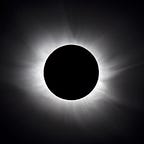What does ‘syzygy’ have to do with August’s eclipse?
The alignment of the Earth, Moon and Sun is a simple, yet inspirational moment, and it happens during every Total Solar Eclipse.
Syzygy. “Siz-er-jee.” It doesn’t exactly roll off the tongue, but this usually obscure astronomical terminology will briefly come back into use when over a hundred million people witness a Total Solar Eclipse this coming August 21.
Syzygy is not a technically difficult concept to understand.
“Syzrgy is when the Earth, Moon and Sun line-up,” says NASA Ambassador Eddie Mahoney, the Director of Astronomy and host of Tour of the Stars at the Hyatt Regency Maui.
Don’t forget yourself in that equation; if you put yourself within the Path of Totality, you’re actually the fourth dimension of that triumvirate. So it’s Sun, Moon, Earth — and you.
A Total Eclipse of the Sun can only happen at New Moon, something that occurs every 28 days (or so) as the Moon completes one orbit of Earth. At that point, the moon is precisely between the Sun and the Earth. It doesn’t always line up exactly, because the Moon follows an elliptical orbit of Earth.
If it did, there would be a solar eclipse every month. Sadly, that’s not the case but don’t feel too aggrieved — that eclipses happen at all is by pure coincidence; the Sun is 400 times bigger than the Moon, but also 400 times further away. Hence, eclipses are mathematically possible.
The moment of Total Solar Eclipse is pure syzygy, but the term is also used to describe other celestial lineups, such as transits, occultations and planetary line-ups in Earth’s night sky. Another famous example of Syzygy is a Total Lunar Eclipse, when the Full Moon is on the other side of Earth.
There’s nothing specific to see during syzygy aside from the effects of viewing an eclipse — chiefly, Totality — but if you think about what is happening, it’s mind-blowing stuff. When you watch a total solar eclipse you are watching nothing less than our corner of the solar system in perfect alignment, right in front of your eyes.
Although there no measurable gravitational effect, there is certainly an effect — it’s inspirational,” says Mahoney.
However, syzygy does have a physical effect on Earth’s oceans; high tides follow every Earth-Moon-Sun alignment.
PS: Thanks for taking the time out to read my post! If you like my blog, please …
1) Leave a comment or press ❤ to recommend it
2) Share it with your network
3) Follow me for future posts (@thenexteclipse)
5) Spend a few dollars on one of my USA eclipse travel guides
6) Visit www.WhenIsTheNextEclipse.com
